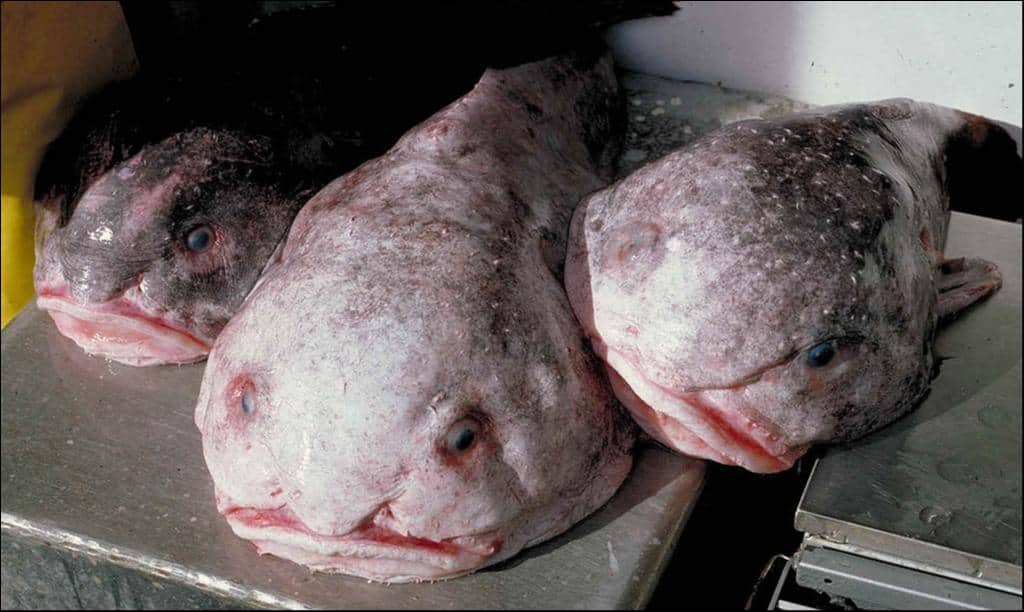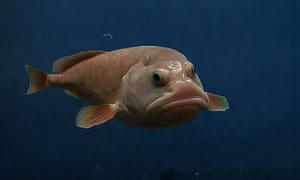What do blobfish and octopuses have in common? Both marine creatures are invertebrates, animals without backbones. Other popular invertebrates include mussels, slugs, jellyfish, butterflies, and crabs!
Blobfish might not have a true backbone, but what about the rest of their body? Are they cartilaginous fish like sharks? Or do blobfish have bones? Read on to find out!
Do Blobfish Have Bones?

The blobfish does not have bones.
©World-Wide-Photography/Shutterstock.com
Blobfish don’t have bones. But they have a soft structure. Their soft structure helps them survive the pressure of deep-sea living. The most recognizable blobfish specimen was discovered by NORFANZ in 2003 and is kept at the Australian Museum. The 2013 winner of the Ugly Animal Preservation Society’s ugliest animal contest, this fish doesn’t look nearly as bad when it’s not out of water.
Some refer to the soft structure as soft bones. However, the blobfish doesn’t have any true bones. If they did, the pressure from the water would crush them. You’ll notice a lot of deep-dwelling sea creatures have soft structures. The giant squid is another great example of an animal surviving without bones.
Why Do Blobfish Appear to Have Big Noses?
Have you seen some of the popular blobfish pictures on the internet? When you see a picture of a blobfish, you can’t help but notice those bulbous eyes and big, round noses.
While it might make you think of a cartoon character, the real reason for its swollen face is due to pressure. When blobfish are brought up from the deep sea, their bodies expand as the pressure around them decreases. This makes their noses look bigger than they are.
Underwater, blobfish doesn’t appear so bulbous. They look quite average and unassuming compared to other fish in the deep sea.
Blobfish Habitat and Range

Blobfish are found in deep waters off the coasts of Australia and new Zealand.
©lacking author information / public domain – License
Where do these boneless blobfish like to live? Blobfish live in the ocean at depths of 2,000 to 4,000 feet. There are healthy blobfish populations off the coasts of Australia and New Zealand. However, it’s hard to catch them in their natural habitat. Their deep-dwelling lifestyle makes blobfish a mysterious creature. Plus, we only learned about them a couple of decades ago.
Most humans will never see a living blobfish, as they only live at depths too deep for human activity. They’re usually dead when we encounter them because they often get caught in fishing nets meant for other sea creatures. Even if blobfish were brought to the surface, they would die quickly due to the change in air pressure.
How Do Blobfish Lay Eggs?
Blobfish are true experts when it comes to laying eggs! These amazing fish can lay thousands of eggs in each nest. What’s even more intriguing is that several female blobfish often gather together to form a big nesting party where they release their eggs into the ocean.
Blobfish seek out nesting spots with sinking water. The sinking water provides a stream of warm water and lots of food. This is an evolutionary strategy. Scientists believe these fish evolved from other species that relied on air sacs. Blobfish had to compete with others for food—and finding areas with ample sustenance was key to surviving.
How Do Boneless Blobfish Babies Survive?
Blobfish babies don’t have bones, but they’re cute! They’re tiny replicas of their parents, often appearing in pink egg nests. The parents clean and monitor the eggs daily to ensure their young’s safety. When the eggs hatch, thousands of blobfish babies emerge!
Unlike most fish species, baby blobfish don’t have to do much to survive—they act like a water balloon, floating in the deep sea until the food comes to their mouth.
It’s good that blobfish can live with very little energy because their habitat is so inhospitable. Deep in the ocean, the pressure is intense, and the water temperature is cold. It’s no wonder that these fish are so mysterious.
How Big Does a Blobfish Get?
Blobfish usually grow to be a foot long. They’re pink fish with soft bones and few muscles. The blobfish’s jelly-like body has a density slightly lower than the water it lives in, which allows it to float just above the ocean floor.
Blobfish can live for more than 100 years. Some records prove blobfish can live for 130 years or more. They have very few predators and a slow rate of growth and reproduction. To survive in the deep sea, they use their soft structure to withstand intense pressure and keep their energy levels low with lots of floating around.
What’s Inside a Blobfish?
What’s inside a blobfish? Well, not much! The most interesting thing about the blobfish is that it doesn’t have a swim bladder. This means its stomach has to stay inside its body at all times. As a result, they rely heavily on their jelly-like structure to support them in deep waters.
Digestion also looks a bit different for blobfish. Since they don’t have teeth, the digestion of food starts in the mouth. They capture their food instead of chewing it and then send it down to their stomach, where it’s churned and mechanically broken down.
Blobfish also have a single, closed circulatory system — meaning that the blood is contained within the vessels and passes through the heart only once when circulating through the body. This helps keep their energy levels low and allows them to float in the deep sea.
What Threats Does the Blobfish Face?

The biggest threats to blobfish are humans.
©Alan Riverstone McCulloch (1885-1925) / public domain – License
Humans are the biggest threat to blobfish. Blobfish are sometimes caught in trawling nets by commercial anglers, and they can die when they reach the surface as they cannot handle the changes in pressure. Blobfish may also be adversely affected by climate change and ocean acidification.
Fortunately, some countries have taken steps to protect these unique creatures. New Zealand and Australia both list blobfish as a protected species, meaning it is illegal to catch or harvest them.
Conclusion
Blobfish are unique creatures that have amazingly adapted to their environment. They don’t have bones as we know them, yet they survive the extreme pressure of deep-sea living. These fish can live for over a hundred years, never needing to hunt and thrive on whatever food sources come their way.
Blobfish may look intimidating, but they’re harmless. Living deep in the water, blobfish is one of the most interesting creatures that people rarely see in real life. From their jelly-like bodies to their single closed circulatory system, they’re a perfect example of nature’s ingenuity.
We hope you’ve had fun learning about blobfish and understanding them better. For more bizarre animals, check out the articles below.
Up Next:
- What Do Blobfish Look Like Underwater & Under Pressure?
- Meet the 370 Million-Year-Old Four-Legged Fish that Walked on Land
- Discover the Snake as Big as a School Bus, The Largest Ever
- Discover the “Rhinosaur” that Weighed 2 Tons and Had Gigantic Fangs
The photo featured at the top of this post is © World-Wide-Photography/Shutterstock.com
Thank you for reading! Have some feedback for us? Contact the AZ Animals editorial team.




